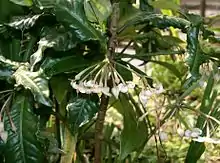Ardisia
Ardisia (coralberry or marlberry) is a genus of flowering plants in the family Primulaceae. It was in the former Myrsinaceae family now recognised as the myrsine sub-family Myrsinoideae.[1] They are distributed in the Americas, Asia, Australia, and the Pacific Islands, mainly in the tropics.[2][3] There are over 700 accepted species.[4] One species, Ardisia japonica is one of the 50 fundamental herbs in traditional Chinese medicine.
| Ardisia | |
|---|---|
 | |
| Ardisia crenata | |
| Scientific classification | |
| Kingdom: | Plantae |
| Clade: | Tracheophytes |
| Clade: | Angiosperms |
| Clade: | Eudicots |
| Clade: | Asterids |
| Order: | Ericales |
| Family: | Primulaceae |
| Subfamily: | Myrsinoideae |
| Genus: | Ardisia Sw. |
| Type species | |
| Ardisia tinifolia | |
| Species | |
|
Over 700, see list of Ardisia species | |
| Synonyms | |
| |
These are trees, shrubs, and subshrubs. Most have alternately arranged leaves. Flowers are borne in many forms of inflorescence. The flowers have usually 4 or 5 green sepals and a bell-shaped corolla of usually 4 or 5 white or pink petals. The fruit is a somewhat fleshy drupe.[2][3] The defining characteristic of the genus is the small tube formed at the center of the flower by the stamens, which are joined at their bases.[5]
Several Ardisia species are the sources of the chemical compounds known as ardisiaquinones.[6]
Species
Selected species include:[4]
- Ardisia amplexicaulis Bedd.
- Ardisia blatteri Gamble
- Ardisia brittonii Stearn
- Ardisia brunnescens E.Walker
- Ardisia byrsonimae Stearn
- Ardisia crenata Sims
- Ardisia crispa (Thunb.) A.DC.
- Ardisia darienensis Lundell
- Ardisia dukei Lundell
- Ardisia elliptica Thunb.
- Ardisia escallonioides Schltdl. & Cham.
- Ardisia etindensis Taton
- Ardisia flavida Pipoly
- Ardisia furfuracella Standl.
- Ardisia gardneri C.B.Clarke
- Ardisia geniculata Lundell
- Ardisia glomerata Lundell
- Ardisia hagenii Lundell
- Ardisia helferiana Kurz.
- Ardisia humilis Vahl
- Ardisia jamaicensis Lundell
- Ardisia javanica A.DC.
- Ardisia jefeana Lundell
- Ardisia koupensis Taton
- Ardisia marginata Blume
- Ardisia maxonii Standl.
- Ardisia nigrita Lundell
- Ardisia olivacea E.Walker
- Ardisia opaca Lundell
- Ardisia panamensis Lundell
- Ardisia paradoxa C.M.Hu & J.E.Vidal
- Ardisia premontana Pipoly
- Ardisia primulifolia Gardner & Champ.
- Ardisia pulverulenta Mez
- Ardisia roseiflora Pit.
- Ardisia rudis J.Sinclair
- Ardisia scheryi Lundell
- Ardisia schlechteri Gilg
- Ardisia schultzei Mez
- Ardisia scortechinii King & Gamble
- Ardisia solanacea Roxb.
- Ardisia solida B.C.Stone
- Ardisia sonchifolia Mez
- Ardisia standleyana P.H.Allen
- Ardisia subsessilifolia Lundell
- Ardisia thomsonii Mez
- Ardisia urbanii Stearn
- Ardisia websteri Pipoly
- Ardisia wightiana (A.DC.) Wall. ex Mez
- Ardisia willisii Mez
- Ardisia zeylanica (Gaertn.) Lam. ex Forsyth f.
References
- Angiosperm Phylogeny Group (2009). "An update of the Angiosperm Phylogeny Group classification for the orders and families of flowering plants: APG III". Botanical Journal of the Linnean Society. 161 (2): 116 (105–121). doi:10.1111/j.1095-8339.2009.00996.x.
- Ardisia. Flora of North America.
- Ardisia. Flora of China.
- "Ardisia Sw". Plants of the World Online. Royal Botanical Gardens Kew. Retrieved 6 January 2019.
- Pipoly, J. J. and J. M. Ricketson. (2005). New species and nomenclatural notes in Mesoamerican Ardisia (Myrsinaceae). Novon 15(1), 190-201.
- Narayanaswamy, Radhakrishnan; Veeraragavan, Vijayakumar (2020). "Natural products as antiinflammatory agents". Bioactive Natural Products. Studies in Natural Products Chemistry. Vol. 67. pp. 269–306. doi:10.1016/B978-0-12-819483-6.00008-4. ISBN 9780128194836. S2CID 224940163.